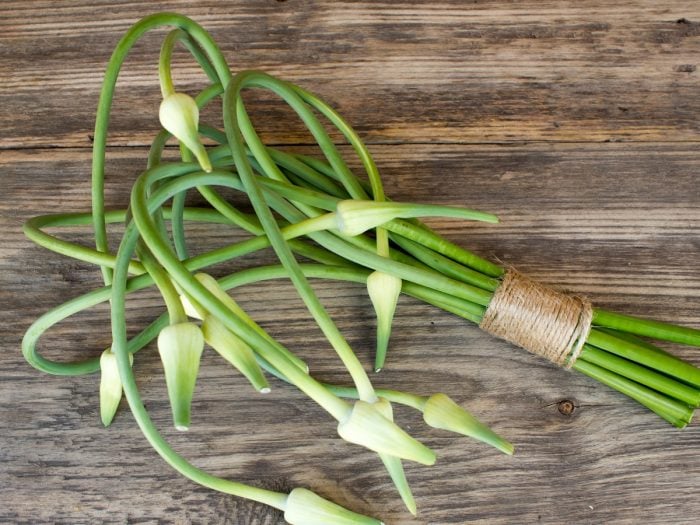If you haven’t cooked with garlic scapes, you are missing out on a simple and mildly flavorful part of the garlic plant that is only available for a limited time each year.
What Are Garlic Scapes?
Garlic scapes are the long flower bud of the garlic plant that grows out of the bulb. They can be removed in early summer, as this will allow the bulbs of garlic to grow larger and fuller. These scapes are long, green stalks, with a similar weight and makeup as green onions. The word ‘scape’ is used in other plants, as it means a long, flowerless stalk growing directly from a root. When you remove these scapes, they can be used in a variety of ways, since they have a nearly identical flavor to garlic, albeit slightly less spicy. You can eat the scapes raw, grill them, fry them, or use them as a salad vegetable. The tops of the stem are the most tender and flavorful portions, and many people also enjoy adding them to soups and stews. [1]
These scapes are only available for a few weeks each year, so those who love to cook, make a point of seeking out these flavorful additions to summer recipes. Since they come directly from the garlic bulb, these scapes also contain a rich supply of vital nutrients and minerals, as well as certain active ingredients and antioxidants. They are very low in calories – only 30 calories per 100 grams – as well as good amounts of dietary fiber, vitamin C, and provitamin A. [2]

Garlic scapes are the stalks that grow from the bulbs of hardneck garlic plants. Photo Credit: Shutterstock
Health Benefits of Garlic Scapes
The best health benefits of garlic scapes include protecting against diseases, improving digestive health, and aiding vision, among others.
Anticancer Potential
Vegetables of the Allium genus, which includes garlic scapes, are known to have several disease-preventing qualities. There are many active ingredients in garlic scapes that have anticancer abilities, but specifically, diallyl sulfides are found in good concentrations in these stalks. These are directly linked to apoptosis, the programmed cell death of cancerous cells, preventing the spread of these cells. [3]
Detoxify the Body
Research has found that regular consumption of garlic scapes can help to flush out the liver and kidneys, thus detoxifying the body. There are also the diuretic properties of this vegetable, which will help the body eliminate waste and toxins rapidly. [4]
Improve Circulation
Garlic is known to boost circulation and oxygen throughout the body, and garlic scapes are no exception to that. Some of the active ingredients in garlic can actually increase the oxygenation of the blood, which can boost energy levels and the speed of repair within the body. [5]
Increase Bone Health
Allicin and allium, two of the active components of garlic scapes, are able to prevent the creation of certain enzymes that speed up the breakdown of bone tissue. This is important as you age and osteoporosis becomes a much bigger risk. [6]
Reduce the risk of Chronic Diseases
The antioxidants present in garlic scapes make it an excellent defense against oxidative stress and chronic disease. This includes conditions like autoimmune diseases. [7]
Improve Vision
Provitamin A, which is found in good quantities in garlic scapes, is able to transform into beta-carotene, a valuable antioxidant that can directly protect vision health. Research has linked this compound to lower rates of macular degeneration and slower advancement of cataracts. [8]
How to Select & Cook Garlic Scapes?
When you are harvesting your scapes, you want to wait until the central stalk has been sent up and has begun to curl. When you cut this, you are basically telling the plant to direct all of its resources to the bulb, rather than to extend the flower bud. The scape should be firm, similar to a ripe green onion. You can store garlic scapes for 2-3 weeks in the refrigerator, but they are best used in this time period to maintain their flavor. You can also keep them in a jar of cool water for 2-3 days, rather than putting them in the refrigerator.
You can cook garlic scapes in various ways, including pickling them, sauteeing them and adding them to pizza, or simply frying them like asparagus. You can spice them in many ways, and even slice them into a salad if you prefer.
